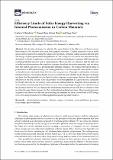| dc.contributor.author | Boriskina, Svetlana V | |
| dc.contributor.author | Zhou, Jiawei | |
| dc.contributor.author | Ding, Zhiwei | |
| dc.contributor.author | Chen, Gang | |
| dc.date.accessioned | 2018-03-27T17:52:11Z | |
| dc.date.available | 2018-03-27T17:52:11Z | |
| dc.date.issued | 2018-02 | |
| dc.date.submitted | 2018-02 | |
| dc.identifier.issn | 2304-6732 | |
| dc.identifier.uri | http://hdl.handle.net/1721.1/114409 | |
| dc.description.abstract | We describe strategies to estimate the upper limits of the efficiency of photon energy harvesting via hot electron extraction from gapless absorbers. Gapless materials such as noble metals can be used for harvesting the whole solar spectrum, including visible and near-infrared light. The energy of photo-generated non-equilibrium or ‘hot’ charge carriers can be harvested before they thermalize with the crystal lattice via the process of their internal photo-emission (IPE) through the rectifying Schottky junction with a semiconductor. However, the low efficiency and the high cost of noble metals necessitates the search for cheaper abundant alternative materials, and we show here that carbon can serve as a promising IPE material candidate. We compare the upper limits of performance of IPE photon energy-harvesting platforms, which incorporate either gold or carbon as the photoactive material where hot electrons are generated. Through a combination of density functional theory, joint electron density of states calculations, and Schottky diode efficiency modeling, we show that the material electron band structure imposes a strict upper limit on the achievable efficiency of the IPE devices. Our calculations reveal that graphite is a good material candidate for the IPE absorber for harvesting visible and near-infrared photons. Graphite electron density of states yields a sizeable population of hot electrons with energies high enough to be collected across the potential barrier. We also discuss the mechanisms that prevent the IPE device efficiency from reaching the upper limits imposed by their material electron band structures. The proposed approach is general and allows for efficient pre-screening of materials for their potential use in IPE energy converters and photodetectors within application-specific spectral windows. Keywords: internal photo-emission; photon energy conversion; non-equilibrium processes; solar energy; photo-detection | en_US |
| dc.description.sponsorship | Solid-State Solar-Thermal Energy Conversion Center (Award DE-SC0001299/DE-FG02-09ER46577) | en_US |
| dc.publisher | Multidisciplinary Digital Publishing Institute | en_US |
| dc.relation.isversionof | http://dx.doi.org/10.3390/photonics5010004 | en_US |
| dc.rights | Creative Commons Attribution | en_US |
| dc.rights.uri | http://creativecommons.org/licenses/by/4.0/ | en_US |
| dc.source | Multidisciplinary Digital Publishing Institute | en_US |
| dc.title | Efficiency Limits of Solar Energy Harvesting via Internal Photoemission in Carbon Materials | en_US |
| dc.type | Article | en_US |
| dc.identifier.citation | Svetlana Boriskina, et al. “Efficiency Limits of Solar Energy Harvesting via Internal Photoemission in Carbon Materials.” Photonics, vol. 5, no. 1, Feb. 2018, p. 4. © 2018 the Authors | en_US |
| dc.contributor.department | Massachusetts Institute of Technology. Department of Materials Science and Engineering | en_US |
| dc.contributor.department | Massachusetts Institute of Technology. Department of Mechanical Engineering | en_US |
| dc.contributor.mitauthor | Boriskina, Svetlana V | |
| dc.contributor.mitauthor | Zhou, Jiawei | |
| dc.contributor.mitauthor | Ding, Zhiwei | |
| dc.contributor.mitauthor | Chen, Gang | |
| dc.relation.journal | Photonics | en_US |
| dc.eprint.version | Final published version | en_US |
| dc.type.uri | http://purl.org/eprint/type/JournalArticle | en_US |
| eprint.status | http://purl.org/eprint/status/PeerReviewed | en_US |
| dc.date.updated | 2018-02-27T14:25:34Z | |
| dspace.orderedauthors | Boriskina, Svetlana V.; Zhou, Jiawei; Ding, Zhiwei; Chen, Gang | en_US |
| dspace.embargo.terms | N | en_US |
| dc.identifier.orcid | https://orcid.org/0000-0002-9872-5688 | |
| dc.identifier.orcid | https://orcid.org/0000-0002-2612-7750 | |
| dc.identifier.orcid | https://orcid.org/0000-0002-3968-8530 | |
| mit.license | PUBLISHER_CC | en_US |
